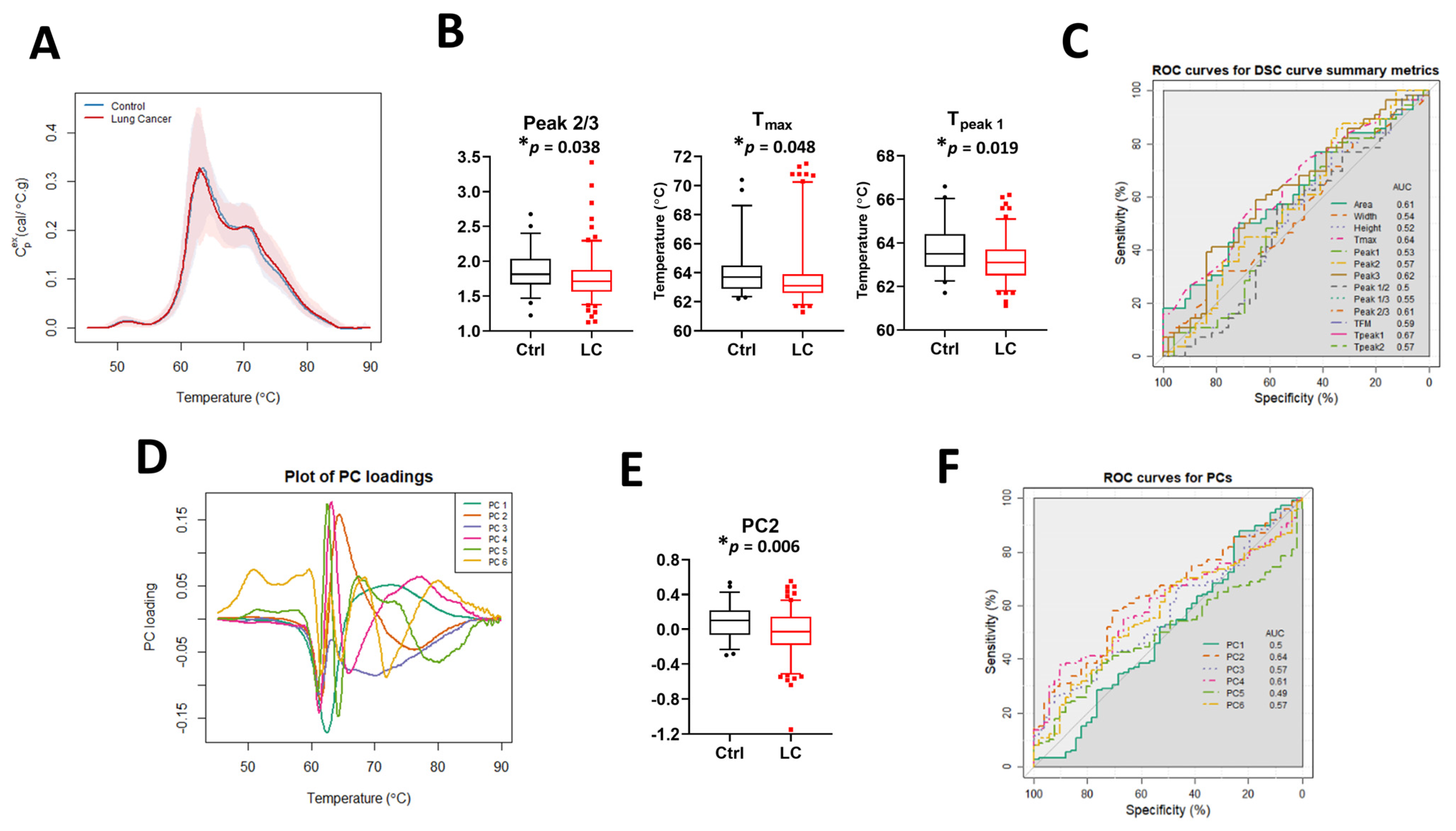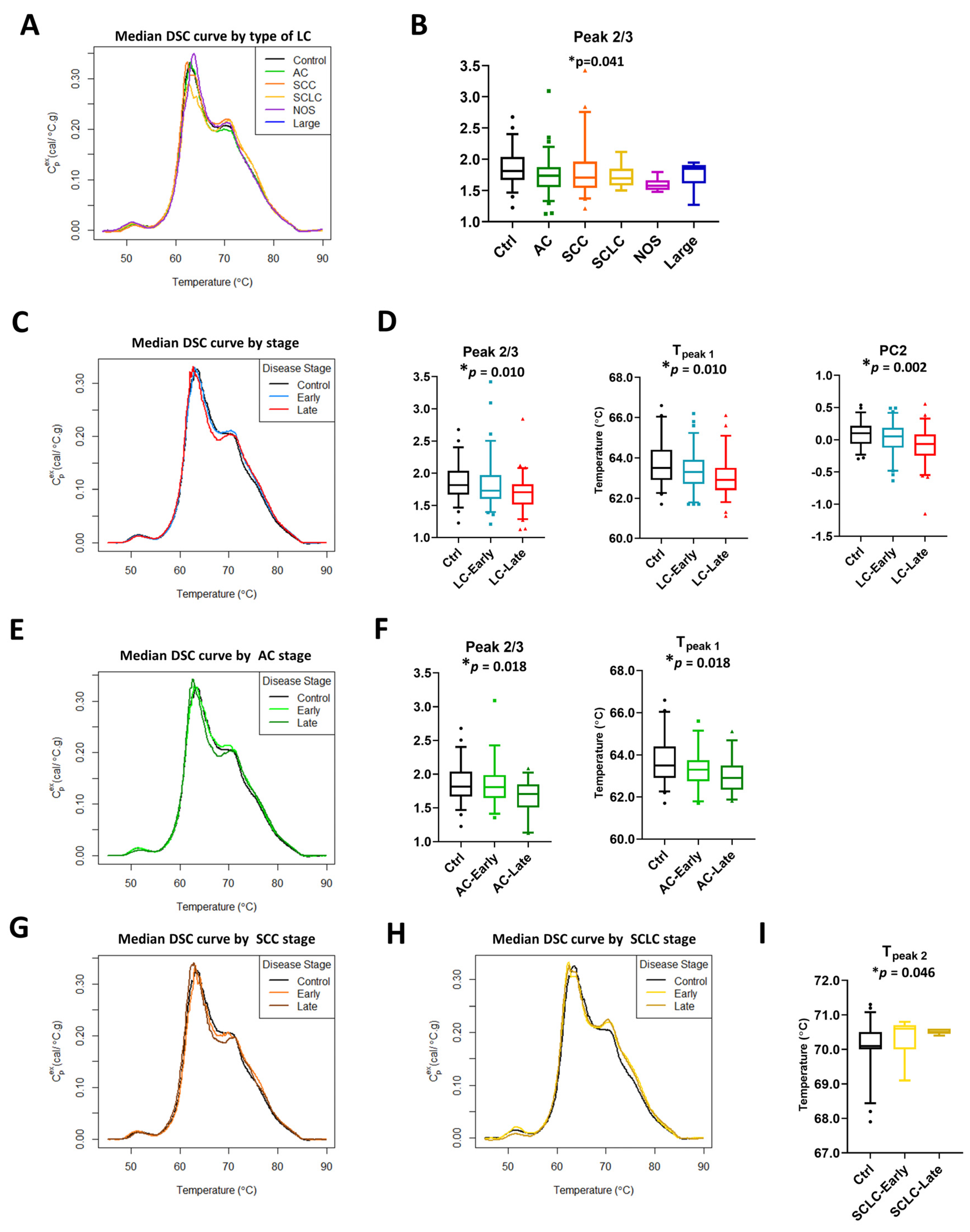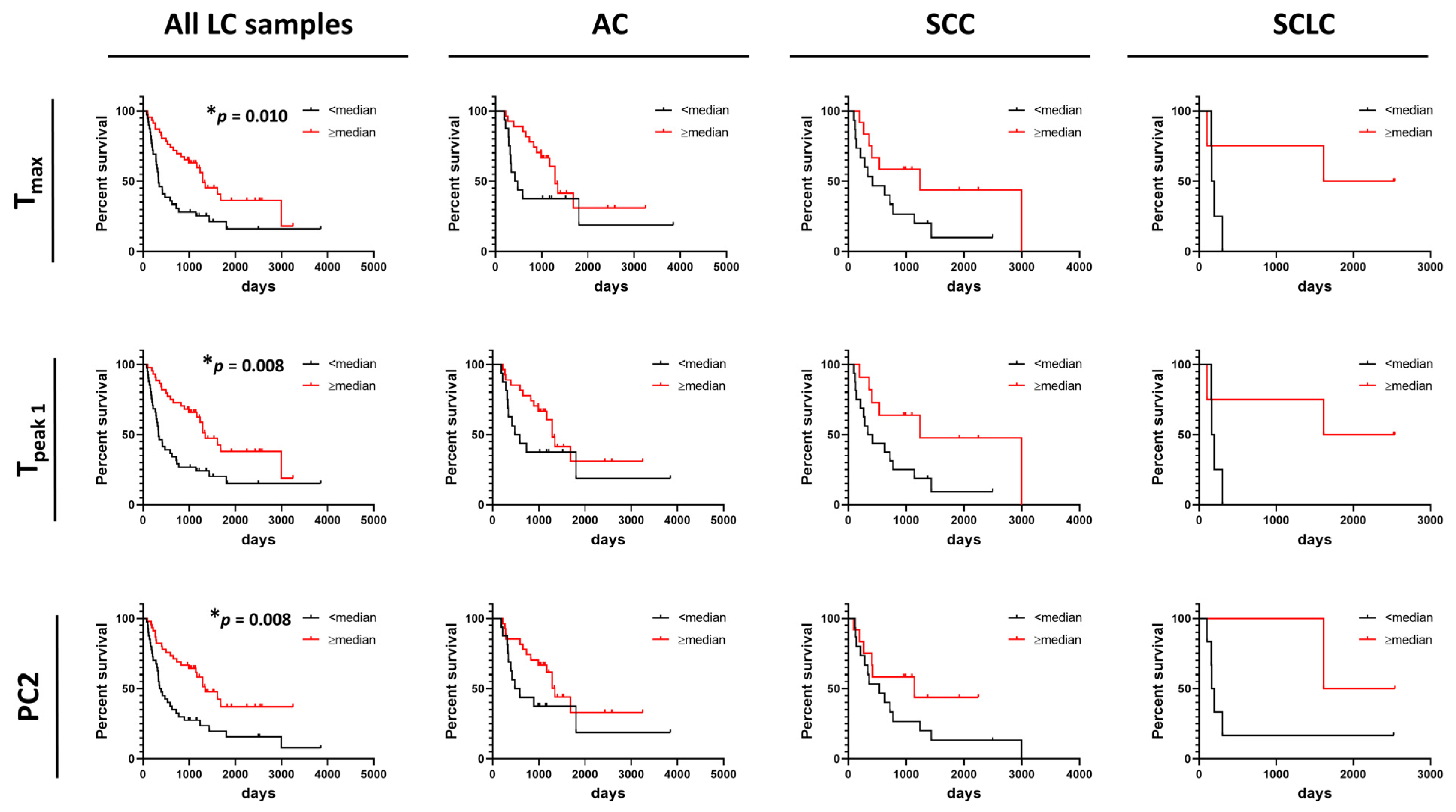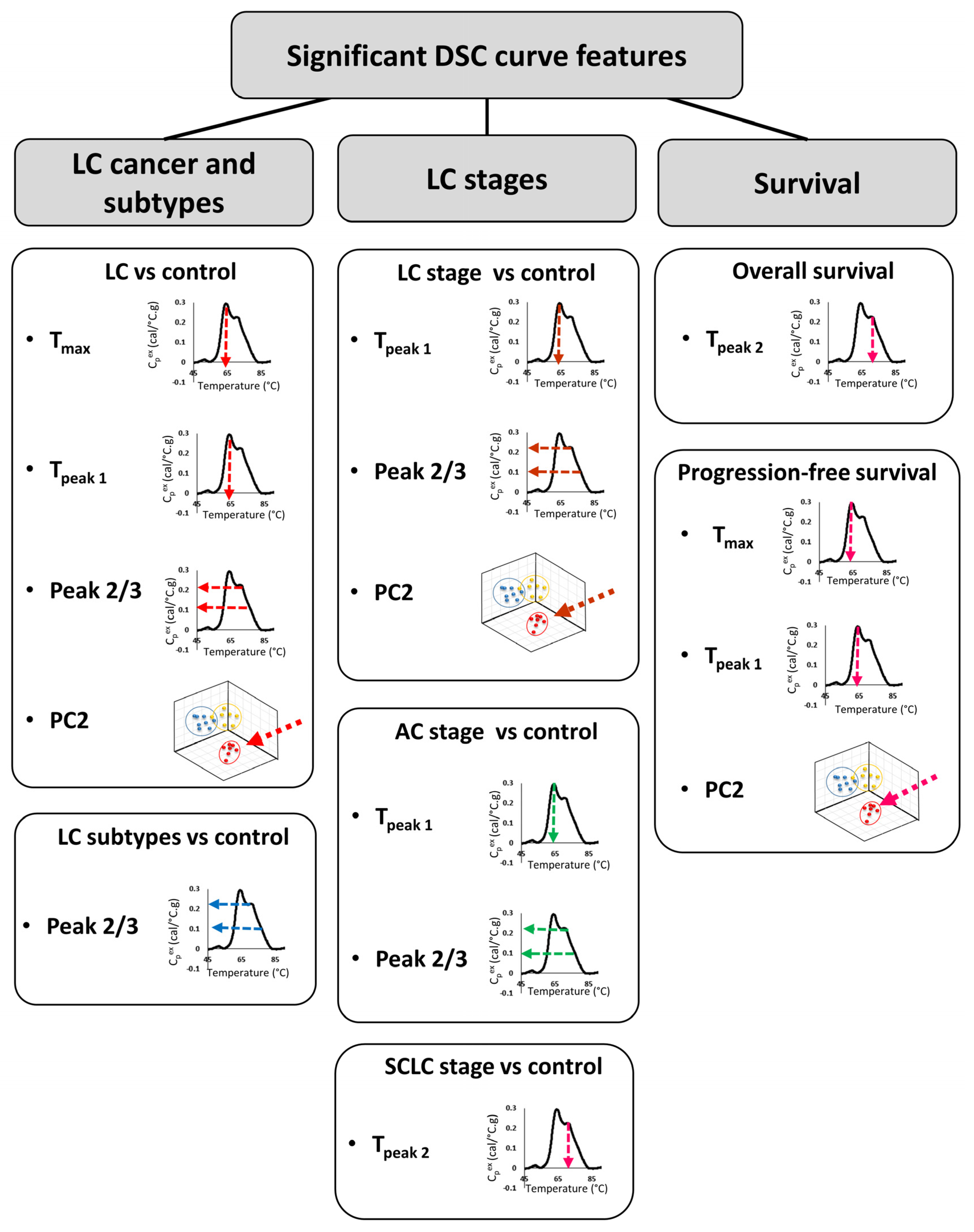The Utility of Differential Scanning Calorimetry Curves of Blood Plasma for Diagnosis, Subtype Differentiation and Predicted Survival in Lung Cancer
Abstract
:Simple Summary
Abstract
1. Introduction
2. Materials and Methods
2.1. Patient Population
2.2. DSC Sample Preparation
2.3. Collection of DSC Curves
2.4. Mass Spectrometry
2.4.1. Sample Digestion
2.4.2. Tandem Mass Tag Labeling
2.4.3. Deglycosylation of the TMT Sample Flights
2.4.4. Liquid Chromatography
2.4.5. Data Acquisition
2.4.6. Data Analysis with Proteome Discoverer v2.1.1.21
2.5. Statistical Analysis of DSC Curves
3. Results
3.1. Comparison of DSC Curves between LC Patients and Controls
| Parameter | Range | Control (n = 51) | LC (n = 148) | Unadjusted p-Value | FDR 1 Adjusted p-Value |
|---|---|---|---|---|---|
| Tmax | <median | 25 (49.0%) | 99 (66.9%) | * 0.0293 | 0.1856 |
| ≥median | 26 (51.0%) | 49 (33.1%) | |||
| Tpeak1 | <median | 23 (45.1%) | 99 (66.9%) | * 0.0076 | 0.1444 |
| ≥median | 28 (54.9%) | 49 (33.1%) | |||
| Tpeak2 | Outside IQR | 23 (45.1%) | 93 (62.8%) | * 0.0325 | 0.3088 |
| Within IQR | 28 (54.9%) | 55 (37.2%) | |||
| PC2 | <median | 25 (49.0%) | 100 (67.6%) | * 0.0283 | 0.1856 |
| ≥median | 26 (51.0%) | 48 (32.4%) | |||
| PC5 | Outside IQR | 26 (51.0%) | 105 (70.9%) | * 0.0159 | 0.3021 |
| Within IQR | 25 (49.0%) | 43 (29.1%) |
3.2. Smoking-Related Differences between LC and Control Patients
3.3. Impact of Stage and Type of Cancer on DSC Curves
3.4. Glycosylation as a Possible Post-Translational Modification Affecting DSC Curves
| FIBRINOGEN | ||||||||
| ANOVA Summary | Unadjusted p-Value | FDR 1 Adjusted p-Value | ||||||
| <0.0001 | 0.0002 | |||||||
| Tukey’s multiple comparison tests | ||||||||
| Control | AC | SCC | SCLC | |||||
| Early | Late | Early | Late | Lim | Ext | |||
| Control | X | <0.0001 | <0.0001 | 0.0017 | <0.0001 | <0.0001 | <0.0001 | |
| AC | Early | <0.0001 | X | 0.0011 | <0.0001 | <0.0001 | ns | <0.0001 |
| Late | <0.0001 | 0.011 | X | ns | <0.0001 | 0.0107 | <0.0001 | |
| SCC | Early | 0.0017 | <0.0001 | ns | X | <0.0001 | <0.0001 | <0.0001 |
| Late | <0.0001 | <0.0001 | <0.0001 | <0.0001 | X | <0.0001 | <0.0001 | |
| SCLC | Lim | <0.0001 | ns | 0.0107 | <0.0001 | <0.0001 | X | <0.0001 |
| Ext | <0.0001 | <0.0001 | <0.0001 | <0.0001 | <0.0001 | <0.0001 | X | |
| APOLIPOPROTEIN A-I | ||||||||
| ANOVA Summary | Unadjusted p-Value | FDR 1 Adjusted p-Value | ||||||
| <0.0001 | 0.0002 | |||||||
| Tukey’s multiple comparison tests | ||||||||
| Control | AC | SCC | SCLC | |||||
| Early | Late | Early | Late | Lim | Ext | |||
| Control | X | 0.0214 | <0.0001 | <0.0001 | 0.0001 | 0.0002 | <0.0001 | |
| AC | Early | 0.0214 | X | <0.0001 | <0.0001 | 0.0007 | 0.0004 | <0.0001 |
| Late | <0.0001 | <0.0001 | X | 0.0169 | 0.0214 | <0.0001 | ns | |
| SCC | Early | <0.0001 | <0.0001 | 0.0169 | X | ns | ns | ns |
| Late | 0.0001 | 0.0007 | 0.0214 | ns | X | ns | ns | |
| SCLC | Lim | 0.0002 | 0.0004 | <0.0001 | ns | ns | X | 0.0011 |
| Ext | <0.0001 | <0.0001 | ns | ns | ns | 0.0011 | X | |
| ALPHA 1-ANTITRYPSIN | ||||||||
| ANOVA Summary | Unadjusted p-Value | FDR 1 Adjusted p-Value | ||||||
| <0.0001 | 0.0002 | |||||||
| Tukey’s multiple comparison tests | ||||||||
| Control | AC | SCC | SCLC | |||||
| Early | Late | Early | Late | Lim | Ext | |||
| Control | X | <0.0001 | <0.0001 | <0.0001 | <0.0001 | ns | <0.0001 | |
| AC | Early | <0.0001 | X | <0.0001 | <0.0001 | <0.0001 | ns | 0.0034 |
| Late | <0.0001 | <0.0001 | X | ns | ns | <0.0001 | ns | |
| SCC | Early | <0.0001 | <0.0001 | ns | X | ns | <0.0001 | ns |
| Late | <0.0001 | <0.0001 | ns | ns | X | 0.0002 | ns | |
| SCLC | Lim | ns | ns | <0.0001 | <0.0001 | 0.0002 | X | 0.0003 |
| Ext | <0.0001 | 0.0034 | ns | ns | ns | 0.0003 | X | |
3.5. Correlation between DSC Curve Summary Metrics and Overall and Progression-Free Survival of Patients
4. Discussion
5. Conclusions
Supplementary Materials
Author Contributions
Funding
Institutional Review Board Statement
Informed Consent Statement
Data Availability Statement
Acknowledgments
Conflicts of Interest
References
- Siegel, R.L.; Miller, K.D.; Jemal, A. Cancer statistics, 2018. CA Cancer J. Clin. 2018, 68, 7–30. [Google Scholar] [CrossRef] [PubMed]
- Noone, A.M.; Howlader, N.; Krapcho, M.; Miller, D.; Brest, A.; Yu, M.; Ruhl, J.; Tatalovich, Z.; Mariotto, A.; Lewis, D.R.; et al. SEER Cancer Statistics Review, 1975–2015; National Cancer Institute: Bethesda, MD, USA, 2018; Based on November 2017 SEER data submission, posted to the SEER web site, April 2018. Available online: https://seer.cancer.gov/csr/1975_2015/ (accessed on 28 May 2019).
- Alberg, A.J.; Samet, J.M. Epidemiology of lung cancer. Chest 2003, 123, 21S–49S. [Google Scholar] [CrossRef] [PubMed] [Green Version]
- US Department of Health and Human Services. The Health Consequences of Smoking-50 Years of Progress: A Report of the Surgeon General. Reports of the Surgeon General; US Department of Health and Human Services: Atlanta, GA, USA, 2014.
- National Lung Screening Trial Research Team; Aberle, D.R.; Adams, A.M.; Berg, C.D.; Black, W.C.; Clapp, J.D.; Fagerstrom, R.M.; Gareen, I.F.; Gatsonis, C.; Marcus, P.M.; et al. Reduced lung-cancer mortality with low-dose computed tomographic screening. N. Engl. J. Med. 2011, 365, 395–409. [Google Scholar] [CrossRef] [PubMed] [Green Version]
- Siegel, D.A.; Fedewa, S.A.; Henley, S.J.; Pollack, L.A.; Jemal, A. Proportion of Never Smokers among Men and Women With Lung Cancer in 7 US States. JAMA Oncol. 2020, 7, 302–304. [Google Scholar] [CrossRef] [PubMed]
- Shaughnessy, A.F. High False-Positive Rate with Lung Cancer Screening. Am. Fam. Phys. 2017, 96, 128–129. [Google Scholar]
- Garbett, N.C.; Merchant, M.L.; Helm, C.W.; Jenson, A.B.; Klein, J.B.; Chaires, J.B. Detection of cervical cancer biomarker patterns in blood plasma and urine by differential scanning calorimetry and mass spectrometry. PLoS ONE 2014, 9, e84710. [Google Scholar] [CrossRef]
- Velazquez-Campoy, A.; Vega, S.; Sanchez-Gracia, O.; Lanas, A.; Rodrigo, A.; Kaliappan, A.; Hall, M.B.; Nguyen, T.Q.; Brock, G.N.; Chesney, J.A.; et al. Thermal liquid biopsy for monitoring melanoma patients under surveillance during treatment: A pilot study. Biochim. Biophys. Acta Gen. Subj. 2018, 1862, 1701–1710. [Google Scholar] [CrossRef]
- Todinova, S.; Krumova, S.; Gartcheva, L.; Robeerst, C.; Taneva, S.G. Microcalorimetry of blood serum proteome: A modified interaction network in the multiple myeloma case. Anal. Chem. 2011, 83, 7992–7998. [Google Scholar] [CrossRef]
- Garbett, N.C.; Mekmaysy, C.S.; Helm, C.W.; Jenson, A.B.; Chaires, J.B. Differential scanning calorimetry of blood plasma for clinical diagnosis and monitoring. Exp. Mol. Pathol. 2009, 86, 186–191. [Google Scholar] [CrossRef]
- Faroongsarng, D.; Sunpaweravong, S.; Raksawong, A. Thermally Induced Denaturing Energetics of Human Blood Plasma Albumin by Differential Scanning Calorimetry (DSC) as an Indicator for Breast Cancer Diagnosis in Female Patients. AAPS PharmSciTech 2019, 20, 146. [Google Scholar] [CrossRef]
- Todinova, S.; Krumova, S.; Kurtev, P.; Dimitrov, V.; Djongov, L.; Dudunkov, Z.; Taneva, S.G. Calorimetry-based profiling of blood plasma from colorectal cancer patients. Biochim. Biophys. Acta 2012, 1820, 1879–1885. [Google Scholar] [CrossRef]
- Chagovetz, A.A.; Quinn, C.; Damarse, N.; Hansen, L.D.; Chagovetz, A.M.; Jensen, R.L. Differential scanning calorimetry of gliomas: A new tool in brain cancer diagnostics? Neurosurgery 2013, 73, 289–295, discussion 295. [Google Scholar] [CrossRef] [PubMed] [Green Version]
- Garbett, N.C.; Miller, J.J.; Jenson, A.B.; Chaires, J.B. Calorimetry outside the box: A new window into the plasma proteome. Biophys. J. 2008, 94, 1377–1383. [Google Scholar] [CrossRef] [Green Version]
- Stowell, S.R.; Ju, T.; Cummings, R.D. Protein glycosylation in cancer. Annu. Rev. Pathol. 2015, 10, 473–510. [Google Scholar] [CrossRef] [Green Version]
- Pinho, S.S.; Reis, C.A. Glycosylation in cancer: Mechanisms and clinical implications. Nat. Rev. Cancer 2015, 15, 540–555. [Google Scholar] [CrossRef]
- Arnold, J.N.; Saldova, R.; Galligan, M.C.; Murphy, T.B.; Mimura-Kimura, Y.; Telford, J.E.; Godwin, A.K.; Rudd, P.M. Novel glycan biomarkers for the detection of lung cancer. J. Proteome Res. 2011, 10, 1755–1764. [Google Scholar] [CrossRef] [PubMed]
- Ruhaak, L.R.; Taylor, S.L.; Stroble, C.; Nguyen, U.T.; Parker, E.A.; Song, T.; Lebrilla, C.B.; Rom, W.N.; Pass, H.; Kim, K.; et al. Differential N-Glycosylation Patterns in Lung Adenocarcinoma Tissue. J. Proteome Res. 2015, 14, 4538–4549. [Google Scholar] [CrossRef] [PubMed]
- Garbett, N.C.; Mekmaysy, C.S.; DeLeeuw, L.; Chaires, J.B. Clinical application of plasma thermograms. Utility, practical approaches and considerations. Methods 2015, 76, 41–50. [Google Scholar] [CrossRef] [PubMed] [Green Version]
- Zheng, Y.; Merchant, M.L.; Burke, T.J.; Ritzenthaler, J.D.; Li, M.; Gaweda, A.E.; Benz, F.W.; Roman, J.; Watson, W.H. Redox States of Protein Cysteines in Pathways of Protein Turnover and Cytoskeleton Dynamics Are Changed with Aging and Reversed by Slc7a11 Restoration in Mouse Lung Fibroblasts. Oxid. Med. Cell. Longev. 2020, 2020, 2468986. [Google Scholar] [CrossRef]
- R Core Team. R: A Language and Environment for Statistical Computing. Available online: https://www.R-project.org/ (accessed on 12 May 2020).
- Jafari, M.; Ansari-Pour, N. Why, When and How to Adjust Your P Values? Cell J. 2019, 20, 604–607. [Google Scholar] [CrossRef] [PubMed]
- Rodrigo, A.; Ojeda, J.L.; Vega, S.; Sanchez-Gracia, O.; Lanas, A.; Isla, D.; Velazquez-Campoy, A.; Abian, O. Thermal Liquid Biopsy (TLB): A Predictive Score Derived from Serum Thermograms as a Clinical Tool for Screening Lung Cancer Patients. Cancers 2019, 11, 1012. [Google Scholar] [CrossRef] [PubMed] [Green Version]
- Kedra-Krolik, K.; Chmielewska, I.; Michnik, A.; Zarzycki, P. Blood Serum Calorimetry Indicates the Chemotherapeutic Efficacy in Lung Cancer Treatment. Sci. Rep. 2017, 7, 16796. [Google Scholar] [CrossRef] [Green Version]
- Rai, S.N.; Srivastava, S.; Pan, J.; Wu, X.; Rai, S.P.; Mekmaysy, C.S.; DeLeeuw, L.; Chaires, J.B.; Garbett, N.C. Multi-group diagnostic classification of high-dimensional data using differential scanning calorimetry plasma thermograms. PLoS ONE 2019, 14, e0220765. [Google Scholar] [CrossRef]
- Tsvetkov, P.O.; Tabouret, E.; Roman, A.Y.; Romain, S.; Bequet, C.; Ishimbaeva, O.; Honore, S.; Figarella-Branger, D.; Chinot, O.; Devred, F. Differential scanning calorimetry of plasma in glioblastoma: Toward a new prognostic/monitoring tool. Oncotarget 2018, 9, 9391–9399. [Google Scholar] [CrossRef] [PubMed] [Green Version]
- Ferencz, A.; Zapf, I.; Lőrinczy, D. Harmful effect of neoadjuvant chemotherapy monitoring by DSC on breast cancer patients’ blood plasma. J. Therm. Anal. Calorim. 2016, 126, 55–59. [Google Scholar] [CrossRef]
- Wang, X.; Deng, Z.; Huang, C.; Zhu, T.; Lou, J.; Wang, L.; Li, Y. Differential N-glycan patterns identified in lung adenocarcinoma by N-glycan profiling of formalin-fixed paraffin-embedded (FFPE) tissue sections. J. Proteom. 2018, 172, 1–10. [Google Scholar] [CrossRef]
- Rho, J.H.; Roehrl, M.H.; Wang, J.Y. Glycoproteomic analysis of human lung adenocarcinomas using glycoarrays and tandem mass spectrometry: Differential expression and glycosylation patterns of vimentin and fetuin A isoforms. Protein J. 2009, 28, 148–160. [Google Scholar] [CrossRef] [PubMed]
- Ueda, K.; Fukase, Y.; Katagiri, T.; Ishikawa, N.; Irie, S.; Sato, T.A.; Ito, H.; Nakayama, H.; Miyagi, Y.; Tsuchiya, E.; et al. Targeted serum glycoproteomics for the discovery of lung cancer-associated glycosylation disorders using lectin-coupled ProteinChip arrays. Proteomics 2009, 9, 2182–2192. [Google Scholar] [CrossRef] [PubMed]
- Ruhaak, L.R.; Nguyen, U.T.; Stroble, C.; Taylor, S.L.; Taguchi, A.; Hanash, S.M.; Lebrilla, C.B.; Kim, K.; Miyamoto, S. Enrichment strategies in glycomics-based lung cancer biomarker development. Proteom. Clin. Appl. 2013, 7, 664–676. [Google Scholar] [CrossRef] [Green Version]
- Ruhaak, L.R.; Stroble, C.; Dai, J.; Barnett, M.; Taguchi, A.; Goodman, G.E.; Miyamoto, S.; Gandara, D.; Feng, Z.; Lebrilla, C.B.; et al. Serum Glycans as Risk Markers for Non-Small Cell Lung Cancer. Cancer Prev. Res. 2016, 9, 317–323. [Google Scholar] [CrossRef] [PubMed] [Green Version]
- Hongsachart, P.; Huang-Liu, R.; Sinchaikul, S.; Pan, F.M.; Phutrakul, S.; Chuang, Y.M.; Yu, C.J.; Chen, S.T. Glycoproteomic analysis of WGA-bound glycoprotein biomarkers in sera from patients with lung adenocarcinoma. Electrophoresis 2009, 30, 1206–1220. [Google Scholar] [CrossRef]
- Ueda, K.; Takami, S.; Saichi, N.; Daigo, Y.; Ishikawa, N.; Kohno, N.; Katsumata, M.; Yamane, A.; Ota, M.; Sato, T.A.; et al. Development of serum glycoproteomic profiling technique; simultaneous identification of glycosylation sites and site-specific quantification of glycan structure changes. Mol. Cell. Proteom. MCP 2010, 9, 1819–1828. [Google Scholar] [CrossRef]
- Vasseur, J.A.; Goetz, J.A.; Alley, W.R., Jr.; Novotny, M.V. Smoking and lung cancer-induced changes in N-glycosylation of blood serum proteins. Glycobiology 2012, 22, 1684–1708. [Google Scholar] [CrossRef] [PubMed] [Green Version]
- Zeng, X.; Hood, B.L.; Sun, M.; Conrads, T.P.; Day, R.S.; Weissfeld, J.L.; Siegfried, J.M.; Bigbee, W.L. Lung cancer serum biomarker discovery using glycoprotein capture and liquid chromatography mass spectrometry. J. Proteome Res. 2010, 9, 6440–6449. [Google Scholar] [CrossRef] [Green Version]
- Jin, Y.; Wang, J.; Ye, X.; Su, Y.; Yu, G.; Yang, Q.; Liu, W.; Yu, W.; Cai, J.; Chen, X.; et al. Identification of GlcNAcylated alpha-1-antichymotrypsin as an early biomarker in human non-small-cell lung cancer by quantitative proteomic analysis with two lectins. Br. J. Cancer 2016, 114, 532–544. [Google Scholar] [CrossRef] [Green Version]
- Tsai, H.Y.; Boonyapranai, K.; Sriyam, S.; Yu, C.J.; Wu, S.W.; Khoo, K.H.; Phutrakul, S.; Chen, S.T. Glycoproteomics analysis to identify a glycoform on haptoglobin associated with lung cancer. Proteomics 2011, 11, 2162–2170. [Google Scholar] [CrossRef]
- Fish, D.J.; Brewood, G.P.; Kim, J.S.; Garbett, N.C.; Chaires, J.B.; Benight, A.S. Statistical analysis of plasma thermograms measured by differential scanning calorimetry. Biophys. Chem. 2010, 152, 184–190. [Google Scholar] [CrossRef] [PubMed]
- Garbett, N.C.; Brock, G.N. Differential scanning calorimetry as a complementary diagnostic tool for the evaluation of biological samples. Biochim. Biophys. Acta 2016, 1860, 981–989. [Google Scholar] [CrossRef] [Green Version]
- Kendrick, S.K.; Zheng, Q.; Garbett, N.C.; Brock, G.N. Application and interpretation of functional data analysis techniques to differential scanning calorimetry data from lupus patients. PLoS ONE 2017, 12, e0186232. [Google Scholar] [CrossRef] [PubMed] [Green Version]
- Garbett, N.C.; Brock, G.N.; Chaires, J.B.; Mekmaysy, C.S.; DeLeeuw, L.; Sivils, K.L.; Harley, J.B.; Rovin, B.H.; Kulasekera, K.B.; Jarjour, W.N. Characterization and classification of lupus patients based on plasma thermograms. PLoS ONE 2017, 12, e0186398. [Google Scholar] [CrossRef] [Green Version]







| Characteristic | Control | LC Patients |
|---|---|---|
| N | 51 | 148 |
| Age at diagnosis: median (range) | 62.0 (41–93) | 58.5 (41–87) |
| Sex | ||
| Female | 33 (64.7%) | 76 (51.4%) |
| Male | 18 (35.3%) | 72 (48.6%) |
| Ethnicity | ||
| White | 44 (86.3%) | 116 (78.4%) |
| Black or African American | 6 (11.8%) | 31 (20.9%) |
| Other | 1 (2.0%) | 1 (0.7%) |
| Smoking status | ||
| Current smokers | 15 (29.4%) | 64 (43.2%) |
| Ex-smokers | 27 (52.9%) | 74 (50.0%) |
| Never-smokers | 9 (17.6%) | 7 (4.7%) |
| Unknown | 0 (0.0%) | 3 (2.0%) |
| Lung cancer classification | ||
| NSCLC | ||
| AC | ||
| Total | 70 (100.0%) | |
| Early-stage (1–3a) | 36 (51.4%) | |
| Late-stage (3b–4) | 34 (48.6%) | |
| SCC | ||
| Total | 46 (100.0%) | |
| Early-stage (1–3a) | 23 (50.0%) | |
| Late-stage (3b–4) | 23 (50.0%) | |
| NOS | ||
| Total | 8 (100.0%) | |
| Early-stage (1–3a) | 2 (25.0%) | |
| Late-stage (3b–4) | 6 (75.0%) | |
| Large cell carcinoma | ||
| Total | 6 (100.0%) | |
| Early-stage (1–3a) | 4 (66.7%) | |
| Late-stage (3b–4) | 2 (33.3%) | |
| SCLC | ||
| Total | 16 (100.0%) | |
| Early-stage (Limited) | 11 (68.8%) | |
| Late-stage (Extensive) | 5 (31.3%) | |
| Mixed type | ||
| Total | 2 (100.0%) | |
| Early-stage | 1 (50.0%) | |
| Late-stage | 1 (50.0%) |
Publisher’s Note: MDPI stays neutral with regard to jurisdictional claims in published maps and institutional affiliations. |
© 2021 by the authors. Licensee MDPI, Basel, Switzerland. This article is an open access article distributed under the terms and conditions of the Creative Commons Attribution (CC BY) license (https://creativecommons.org/licenses/by/4.0/).
Share and Cite
Schneider, G.; Kaliappan, A.; Nguyen, T.Q.; Buscaglia, R.; Brock, G.N.; Hall, M.B.; DeSpirito, C.; Wilkey, D.W.; Merchant, M.L.; Klein, J.B.; et al. The Utility of Differential Scanning Calorimetry Curves of Blood Plasma for Diagnosis, Subtype Differentiation and Predicted Survival in Lung Cancer. Cancers 2021, 13, 5326. https://doi.org/10.3390/cancers13215326
Schneider G, Kaliappan A, Nguyen TQ, Buscaglia R, Brock GN, Hall MB, DeSpirito C, Wilkey DW, Merchant ML, Klein JB, et al. The Utility of Differential Scanning Calorimetry Curves of Blood Plasma for Diagnosis, Subtype Differentiation and Predicted Survival in Lung Cancer. Cancers. 2021; 13(21):5326. https://doi.org/10.3390/cancers13215326
Chicago/Turabian StyleSchneider, Gabriela, Alagammai Kaliappan, Taylor Q. Nguyen, Robert Buscaglia, Guy N. Brock, Melissa Barousse Hall, Crissie DeSpirito, Daniel W. Wilkey, Michael L. Merchant, Jon B. Klein, and et al. 2021. "The Utility of Differential Scanning Calorimetry Curves of Blood Plasma for Diagnosis, Subtype Differentiation and Predicted Survival in Lung Cancer" Cancers 13, no. 21: 5326. https://doi.org/10.3390/cancers13215326
APA StyleSchneider, G., Kaliappan, A., Nguyen, T. Q., Buscaglia, R., Brock, G. N., Hall, M. B., DeSpirito, C., Wilkey, D. W., Merchant, M. L., Klein, J. B., Wiese, T. A., Rivas-Perez, H. L., Kloecker, G. H., & Garbett, N. C. (2021). The Utility of Differential Scanning Calorimetry Curves of Blood Plasma for Diagnosis, Subtype Differentiation and Predicted Survival in Lung Cancer. Cancers, 13(21), 5326. https://doi.org/10.3390/cancers13215326







